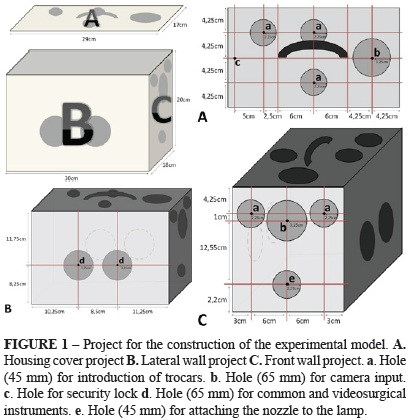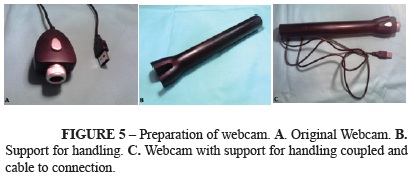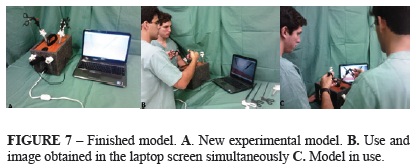Abstracts
PURPOSE: To develop a new experimental model of lower cost for training in videosurgery. METHODS: This project was performed at the Nucleus of Experimental Surgery of the Bahiana School of Medicine and Public Health, based on previous models described in the literature and under the supervision of the full professor of Operative Technique and Experimental Surgery II. It was made a model cube-shaped, made of wood, with holes distributed in various locations, rubber stoppers for the holes and lined externally with carpet, and internally with laminate. RESULTS: The new experimental model is of low cost and reproduces quite faithfully several videosurgical procedures. CONCLUSION: Medical schools interested in the subject may adopt the new model for training in videosurgery without the need of high costs for making and using these models.
Surgery; Laparoscopy; Animal Experimentation; Learning Curve
OBJETIVO: Desenvolver um novo modelo experimental de baixo custo para treinamento em videocirurgia MÉTODOS: Este projeto foi conduzido no Núcleo de Cirurgia Experimental da Escola Bahiana de Medicina e Saúde Pública, baseado em modelos prévios descritos na literatura e sob a supervisão do professor titular de Técnica Operatória e Cirurgia Experimental II. Foi feito um modelo em formato de cubo, de madeira, com furos distribuídos em vários locais, tampas de borracha para os orifícios e forrado externamente com carpete e internamente com laminado. RESULTADOS: O novo modelo experimental desenvolvido é de baixo custo e reproduz de forma bastante fiel diversos procedimentos videocirúrgicos. CONCLUSÃO: Faculdades médicas interessadas no tema poderão adotar o novo modelo para o treinamento em videocirurgia sem que sejam necessários gastos elevados para a confecção e o uso desses modelos.
Cirurgia; Laparoscopia; Experimentação Animal; Curva de Aprendizado
13 - ORIGINAL ARTICLE
TECHNICAL SKILL
New experimental model for training in videosurgery1 1 Research performed at the Nucleus of Experimental Surgery, Bahiana School of Medicine and Public Health (EBMSP), Salvador-BA, Brazil.
Novo modelo experimental para treinamento em videocirurgia
Danilo Malta BatistaI; Victor Araujo FelzemburghII; Ediriomar Peixoto MatosIII
IScientific Initiation student, Division of Surgical Technique and Experimental Surgery I, EBMSP, Salvador-BA, Brazil. Main author. Responsible for conception, design, intellectual and scientific content of the study
IIFellow Master degree, Postgraduate Program in Human Health Technology, EBMSP, Salvador-BA, Brazil. Analysis, interpretation of data and critical revision
IIIPhD, Full Professor, Division of Surgical Technique and Experimental Surgery II, EBMSP, Salvador-BA, Brazil. Conception, design and critical revision
Correspondence Correspondence: Danilo Malta Batista Rua Barão de Loreto, 168 40150-270 Salvador - BA Brasil Tel.: (55 71)9293-5776 dan.malta@hotmail.com
ABSTRACT
PURPOSE: To develop a new experimental model of lower cost for training in videosurgery.
METHODS: This project was performed at the Nucleus of Experimental Surgery of the Bahiana School of Medicine and Public Health, based on previous models described in the literature and under the supervision of the full professor of Operative Technique and Experimental Surgery II. It was made a model cube-shaped, made of wood, with holes distributed in various locations, rubber stoppers for the holes and lined externally with carpet, and internally with laminate.
RESULTS: The new experimental model is of low cost and reproduces quite faithfully several videosurgical procedures.
CONCLUSION: Medical schools interested in the subject may adopt the new model for training in videosurgery without the need of high costs for making and using these models.
Key words: Surgery. Laparoscopy. Animal Experimentation. Learning Curve.
RESUMO
OBJETIVO: Desenvolver um novo modelo experimental de baixo custo para treinamento em videocirurgia
MÉTODOS: Este projeto foi conduzido no Núcleo de Cirurgia Experimental da Escola Bahiana de Medicina e Saúde Pública, baseado em modelos prévios descritos na literatura e sob a supervisão do professor titular de Técnica Operatória e Cirurgia Experimental II. Foi feito um modelo em formato de cubo, de madeira, com furos distribuídos em vários locais, tampas de borracha para os orifícios e forrado externamente com carpete e internamente com laminado.
RESULTADOS: O novo modelo experimental desenvolvido é de baixo custo e reproduz de forma bastante fiel diversos procedimentos videocirúrgicos.
CONCLUSÃO: Faculdades médicas interessadas no tema poderão adotar o novo modelo para o treinamento em videocirurgia sem que sejam necessários gastos elevados para a confecção e o uso desses modelos.
Descritores: Cirurgia. Laparoscopia. Experimentação Animal. Curva de Aprendizado.
Introduction
The operative and surgical techniques have undergone a continuous process of improvement in several specialties. In the field of gastrointestinal surgery, like bariatric surgery, cholecystectomy, appendectomy and treatment of coloproctologic diseases, endoscopic procedures have gained increasing space. In neurosurgery services today, it is often preferable to perform a neuroendoscopy instead of a conventional craniotomy for performing certain intervention1-3.
With the videosurgery entering its maturity, it is essential to maintain the stimulus for training at all levels, including undergraduate medical and not just a future residence4. However, with few exceptions, it is not what is happening in the majority of medical courses in the country. A major reason is the lack of economically viable models that meet the requirements for training in videosurgery like, for example, the existence of a system with images similar to those obtained in actual videosurgery equipment5.
The development of a new experimental model with these features can make medical schools across the country have an effective and inexpensive alternative to institute preparatory courses in videosurgery even during graduate medical students.
Methods
To prepare the experimental model is produced a wood box with the following dimensions: 30 cm (long) x 18 cm (wide) x 20 cm (high). In this box will be made twelve holes with the help of a hole saw attached to a common drill (Figure 1).
In the housing cover (Figures 1A and 2A).are made five holes. Three for trocars inserting (Figure 1A-a), one for the camera input along with support for the handling (Figure 3A-b) and another for the security lock (Figure 1A-d and Figure 2B). The four side holes of the box are the entrance doors to the surgical instruments (Figure 1B-d). Two more holes will be used exclusively for the entry of trocars and videosurgical instruments (Figure 1C-a). One of the holes is used as a switch to the input of the camera along with support for the handling (Figure 1C-b). Another is combined with a nozzle for placement of the lamp (Figure 1C-e).
Will be produced rubber covers to the holes of the same size, removable and with small central holes for insertion of trocars and caps cover holes were placed in round pieces of plywood (Figure 3C). The box will be lined externally with carpet lint beaten and internally with laminate. The socket for the lamp will be connected to a wire with two meters. A switch for lighting the lamp will be installed between the plug for connection to the electrical current and nozzle that is attached to the box (Figure 4).
A video camera (Webcam Leadership® Gotec Mini 1300 k) is modified in its original format. It will bind to a support for the handling. The support is made from a PVC pipe of 15 cm (Figure 5). The video camera is then connected to a standard laptop (Dell Inspiron N5010 Intel® CoreTM i5 CPU M480 @ 2.67GHz 2.66 GHz with 4.00 GB RAM). In the laptop was installed the program AMCAP - DirectShow Video Capture Sample Version 9.00 Copyright© 1997-2002 Microsoft Corp to the reproduction of the webcam (Figure 6).
Results
The time for an individual prepare the experimental model (from the making of the wooden cube, the achievement of the holes in the box, the manufacture of rubbers stoppers, the internal and external finishing, assembly of the lighting system, the changing of camera, and finally the assembly of the model) was calculated and totaled about 3.6 hours (Table 1).
The model is quite satisfactory for the training in videosurgery. When the camera is inserted into the box and connected to the laptop, the images obtained are quite similar to those seen in videosurgical procedures (Figures 6 and 7).
The final cost for the construction of the model was $ 100.00 (Table 2).
Furthermore, it was noted that the felt sense, the difficulty in putting the instrumental on the screen and the challenge to coordinate what is seen on the monitor with what is felt through the instrumental impresses first-time users of the model and encourages training. The process of development was made with the aid of monitors of the discipline of Surgical Technique and Experimental Surgery I of Bahiana School of Medicine and Public Health.
Discussion
The literature describes some models for training in videosurgery5. However, they are expensive or not faithfully reproduce an environment for execution of videosurgical procedures. The experimental model described in this design is intended to simulate a very similar manner inside the body of a patient, such as the abdomen after the completion of a pneumoperitoneum.
The size of the model was based on the size of the videosurgical clamps and size of the space obtained when performing a pneumoperitoneum. The raw material chosen to construct the experimental model was the wood due to the accessibility, low cost and easy handling. The holes in the box simulate the openings made in the patient's abdominal wall, through which the trocars along with the videosurgical optical and clamps.
One of the differences of this model is that the camera can be manipulated through its support by an auxiliary, as in real videosurgery. Therefore, the model can be used both to train surgeons how to train auxiliary who typically handle the optics during surgery. The lamp is used to illuminate the interior of the box, considering that the camera that simulates the videosurgical optical in the present model does not have its own light. The choice of webcam was made on the basis of its low cost and good resolution in the images obtained by use within the box.
Another distinguishing feature of this new model is the rubber stoppers used to seal the holes. They have a small central hole through which trocars and the videosurgical instrumental are inserted. However, as these covers are removable, after its removal is feasible the use of common instruments or surgery, case who are training do not have videosurgical instruments, making the model quite eclectic.
The handle and safety lock has the function of facilitate transport of the box and prevent opening of the lid undue moment. The outer lining is of beaten carpet, because this material increases the friction with the surface on which it is used and prevents slipping during the model training. The interior is lined with laminate for the cleaning of the box is easier, especially if the training is done with organic materials.
A major goal in crating this new model is to enable medical school to institute preparatory courses in laparoscopic surgery using this simple and viable alternative. There are several exercises that student can perform, for example, pinching objects, transfer them with a clip to another or even train videosurgical sutures6.
Conclusion
The present experimental model is simple, reproducible, inexpensive and can be used for training in laparoscopic surgery. Furthermore, several studies can be done like, like for example, about influence of the training in laparoscopic surgery during the graduation of medical students in a possible decrease of the learning curve in videosurgery.
Acknowledgements
The authors would like to thank Joao Bosco de Souza Batista for his aid in the construction of the box, Iasmin Souza Amorim and Daniel Cardoso Cavalcante Guerra for his help in manuscript writing.
Conflict of interest: none
Financial source: none
Received: May 25, 2012
Review: July 27, 2012
Accepted: August 29, 2012
- 1. Ferraz ED, Lacombe D. Estado Atual da Cirurgia Híbrida Colo-Retal. Rev Bras Videocir. 2003;1(1):29-37.
- 2. Guerra AJ, Silva LAS. Simulador eletrônico: uma contribuição para o treinamento inicial em cirurgia videoendoscópica. Acta Cir Bras. 1999;14(3). Disponível em http://www.scielo.br/acb
- 3. Melo MAC. Curva de Aprendizado na Videocirurgia (Editorial). Rev Bras Videocir. 2004;2(3):111-3.
- 4. Pinotti HW, Domene CE, Volpe P, Santo MA, Onari P. Formação do cirurgião em cirurgia laparoscópica do aparelho digestivo. Experiência de 1.818 intervenções sem acidentes e sem mortalidade. Rev Assoc Med Bras. 1999;45(4):337-41.
- 5. Batista EFN, Batista GAP. Treinamento em Videocirurgia - Atualização de modelo de "Caixa Preta" para uso com microcâmera. Rev Bras Videocir. 2006;4(1):21-5.
- 6. Andrade ALL, Filho JDD, Filho SRGC, Pinho AS, Filho AVL, Leite CRC. Prancha simulada de exercícios para treinamento da cirurgia laparoscópica. XI Encontro de Iniciação à Docência. UFPB, João Pessoa-PB; 2008.
- 7. Lauter DM, Froines EJ. Initial experience with 150 cases of laparoscopic assisted colectomy. Am J Surg. 2001;181(5):398-403.
- 8. Voitk AJ, Tsao SGS, Ignatius S. The tail of the learning curve for laparoscopic cholecystectomy. Am J Surg. 2001; 182(3):250-3.
Publication Dates
-
Publication in this collection
27 Sept 2012 -
Date of issue
Oct 2012
History
-
Received
25 May 2012 -
Accepted
29 Aug 2012 -
Reviewed
27 July 2012










